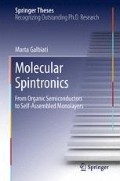Abstract
Organic spintronics field is an emerging field at the frontier between organic chemistry and spintronics. Exploiting the peculiarity of these two fields, it combines the flexibility, versatility and low production cost of organic materials with the nonvolatility, spin degree of freedom and beyond CMOS capabilities offered by spintronics. Before starting the discussion on the organic spintronics field, in this chapter will be provided a brief introduction on organic and molecular electronics and the specificities of molecules. This will help to understand the advantages that molecular systems can bring to spintronics.
Access this chapter
Tax calculation will be finalised at checkout
Purchases are for personal use only
References
C.K. Chiang, C.B. Fincher, J.Y.W. Park, A.J. Heeger, H. Shirakawa, E.J. Louis, S.C. Gau, A.G. MacDiarmid, Electrical conductivity in doped polyacetylene. Phys. Rev. Lett. 39(17), 1098–1101 (1977)
I. Díez-Pérez, J. Hihath, Y. Lee, L. Yu, L. Adamska, M.A. Kozhushner, I.I. Oleynik, N. Tao, Rectification and stability of a single molecular diode with controlled orientation. Nat. Chem. 1, 635–641 (2009)
B. Mann, H. Kuhn, Tunneling through fatty acid salt monolayers. J. Appl. Phys. 42, 4398–4405 (1971)
A. Aviram, M.A. Ratner, Molecular rectifiers. Chem. Phys. Lett. 29(2), 277–283 (1974)
M. Galbiati, S. Tatay, C. Barraud, A.V. Dediu, F. Petroff, R. Mattana, P. Seneor, Spinterface: crafting spintronics at the molecular scale. MRS Bull. 39, 602–607 (2014)
H. Vazquez, R. Oszwaldowski, P. Pou, J. Ortega, R. Pérez, F. Flores, A. Kahn, Dipole formation at metal/PTCDA interfaces: role of the charge neutrality level. EPL (Europhys. Lett.) 65(6), 802 (2004)
M.L. Perrin, C.J.O. Verzijl, C.A. Martin, A.J. Shaikh, R. Eelkema, J.H. van Esch, J.M. van Ruitenbeek, J.M. Thijssen, H.S.J. van der Zant, D. Dulić, Large tunable image-charge effects in single-molecule junctions. Nat. Nanotechnol. 8, 282–287 (2013)
C. Boulas, J. Davidovits, F. Rondelez, D. Vuillaume, Suppression of charge carrier tunneling through organic self-assembled monolayers. Phys. Rev. Lett. 76, 4797–4800 (1996)
M. Cohen, L. Coleman, A. Garito, A. Heeger, Electrical conductivity of tetrathiofulvalinium tetracyanoquinodimethan (TTF) (TCNQ). Phys. Rev. B 10, 1298–1307 (1974)
R.G. Kepler, P.M. Beeson, S.J. Jacobs, R.A. Anderson, M.B. Sinclair, V.S. Valencia, P.A. Cahill, Electron and hole mobility in tris(8-hydroxyquinolinolato-N1, O8) aluminum. Appl. Phys. Lett. 66, 3618 (1995)
G. Horowitz, Organic field-effect transistors. Adv. Mater. 10, 365–377 (1998)
C. Reese, Z. Bao, High-resolution measurement of the anisotropy of charge transport in single crystals. Adv. Mater. 19, 4535–4538 (2007)
Y. Yuan, G. Giri, A.L. Ayzner, A.P. Zoombelt, S.C.B. Mannsfeld, J. Chen, D. Nordlund, M.F. Toney, J. Huang, Z. Bao, Ultra-high mobility transparent organic thin film transistors grown by an off-centre spin-coating method. Nat. Commun. 5, 3005 (2014)
C. Barraud, C. Deranlot, P. Seneor, R. Mattana, B. Dlubak, S. Fusil, K. Bouzehouane, D. Deneuve, F. Petroff, A. Fert, Magnetoresistance in magnetic tunnel junctions grown on flexible organic substrates. Appl. Phys. Lett. 96, 072502 (2010)
S.S.P. Parkin, K.P. Roche, T. Suzuki, Giant magnetoresistance in antiferromagnetic Co/Cu multilayers grown on kapton. Jpn. J. Appl. Phys. 31(9A), 1246–1249 (1992)
S.S.P. Parkin, Flexible giant magnetoresistance sensors. Appl. Phys. Lett. 69(20), 3092–3094 (1996)
F. Yan, G. Xue, F. Wan, A flexible giant magnetoresistance sensor prepared completely by electrochemical synthesis. J. Mater. Chem. 12, 2606–2608 (2002)
T. Uhrmann, L. Bär, T. Dimopoulos, N. Wiese, M. Rührig, A. Lechner, Magnetostrictive GMR sensor on flexible polyimide substrates. J. Magn. Magn. Mater. 307(2), 209 (2006)
A. Bedoya-Pinto, M. Donolato, M. Gobbi, L.E. Hueso, P. Vavassori, Flexible spintronic devices on Kapton. Appl. Phys. Lett. 104, 062412 (2014)
D.R. McCamey, H.A. Seipel, S.Y. Paik, M.J. Walter, N.J. Borys, J.M. Lupton, C. Boehme, Spin Rabi flopping in the photocurrent of a polymer light-emitting diode. Nat. Mater. 7, 723–728 (2008)
C.G. Yang, E. Ehrenfreund, Z.V. Vardeny, Polaron spin-lattice relaxation time in pi-conjugated polymers from optically detected magnetic resonance. Phys. Rev. Lett. 99, 157401 (2007)
S. Sanvito, A.R. Rocha, Molecular-spintronics: the art of driving spin through molecules. J. Comput. Theor. Nanosci. 3, 624–642 (2006)
V.I. Krinichnyi, S.D. Chemerisov, Y.S. Lebedev, EPR and charge-transport studies of polyaniline. Phys. Rev. B 55(24), 16233 (1997)
B. Dlubak, M.-B. Martin, C. Deranlot, B. Servet, S. Xavier, R. Mattana, M. Sprinkle, C. Berger, W.A. De Heer, F. Petroff, A. Anane, P. Seneor, A. Fert, Highly efficient spin transport in epitaxial graphene on SiC. Nat. Phys. 8, 557–561 (2012)
C. Barraud, P. Seneor, R. Mattana, S. Fusil, K. Bouzehouane, C. Deranlot, P. Graziosi, L. Hueso, I. Bergenti, V. Dediu, F. Petroff, A. Fert, Unravelling the role of the interface for spin injection into organic semiconductors. Nat. Phys. 6, 615–620 (2010)
Author information
Authors and Affiliations
Corresponding author
Rights and permissions
Copyright information
© 2016 Springer International Publishing Switzerland
About this chapter
Cite this chapter
Galbiati, M. (2016). Why Bring Organic and Molecular Electronics to Spintronics. In: Molecular Spintronics. Springer Theses. Springer, Cham. https://doi.org/10.1007/978-3-319-22611-8_2
Download citation
DOI: https://doi.org/10.1007/978-3-319-22611-8_2
Published:
Publisher Name: Springer, Cham
Print ISBN: 978-3-319-22610-1
Online ISBN: 978-3-319-22611-8
eBook Packages: Chemistry and Materials ScienceChemistry and Material Science (R0)

